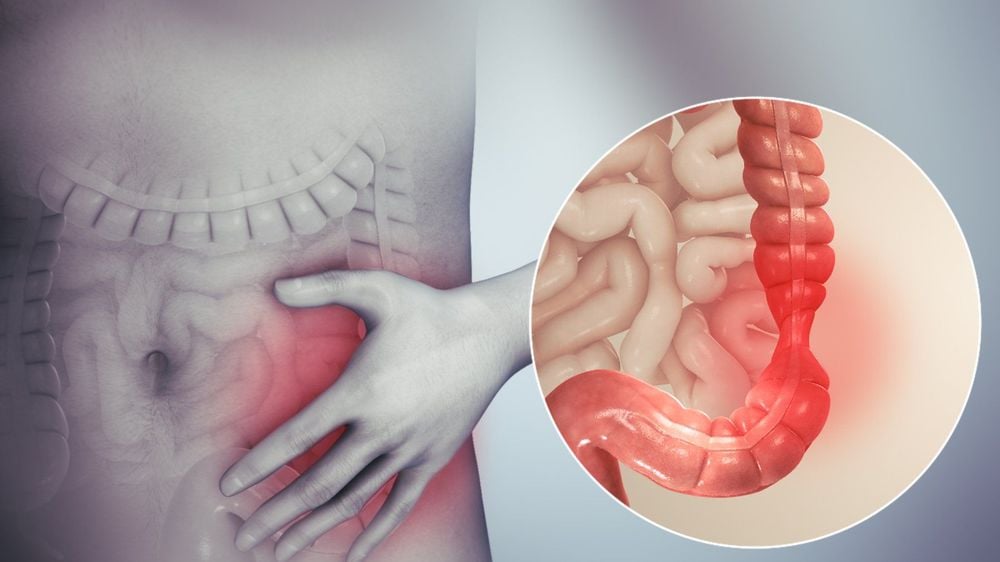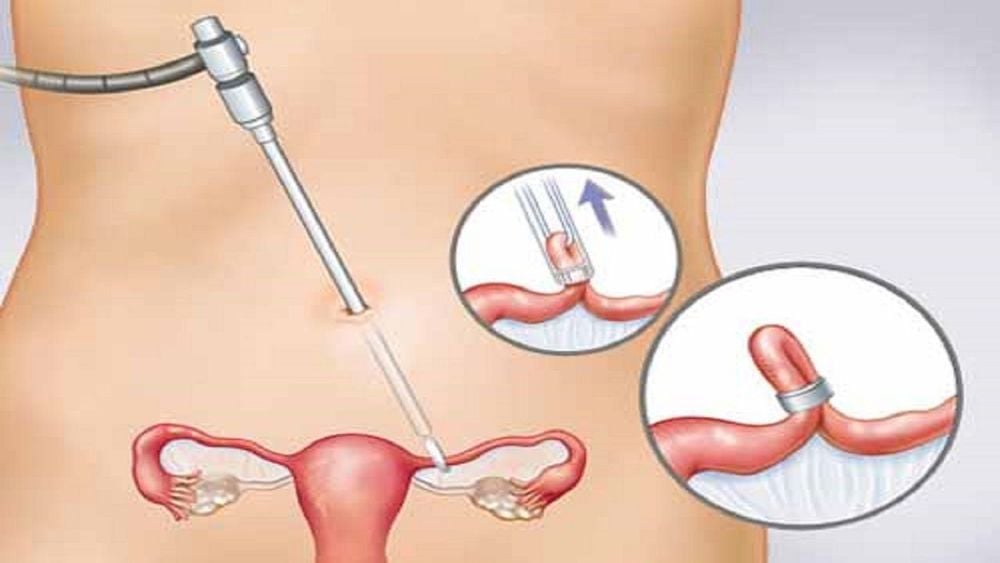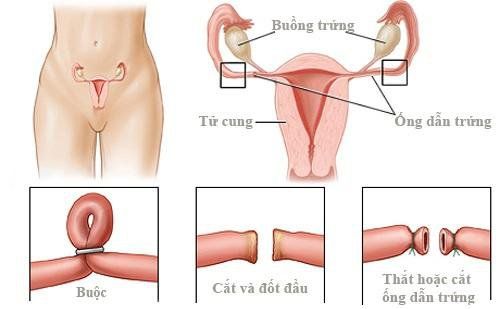This is an automatically translated article.
The article is professionally consulted by Master, Doctor Nguyen Thi Hong On - Department of Obstetrics and Gynecology - Vinmec Phu Quoc International General Hospital.
Tubal ligation is a safe and effective method of birth control. However, it is not absolutely optimal for everyone. Because less than 1 in 100 women will get pregnant in the first year after the procedure. Therefore, when choosing this method, you should be carefully consulted by specialists to avoid the risk of affecting your health.
1. What is tubal ligation?
Tubal ligation is a permanent method of preventing pregnancy in women, also known as female sterilization. The purpose of this process is to prevent an egg from traveling from the ovary to the uterus through the fallopian tube or to prevent sperm from traveling up the fallopian tube for fertilization. This method does not affect a woman's menstrual cycle.Tubal ligation can be done at any time, including after childbirth or in combination with another type of abdominal surgery. A tubal ligation procedure cannot return to its original state if a woman wants to become pregnant. In some special cases, it may be necessary to perform microsurgery to connect the fallopian tubes, but this does not always achieve the desired effect.
Tubal ligation is not 100% effective. In addition, this method also carries some risks such as pregnancy after tubal ligation, but such cases are very rare.

Việc thắt ống dẫn trứng không gây ảnh hưởng đến chu kỳ kinh nguyệt
2. Some risks when performing tubal ligation
Tubal ligation is an operation that involves surgery (making an incision) on the abdomen. Therefore, the procedure requires anesthesia or spinal anesthesia. At the same time, it can pose a number of risks such as:Damage to the intestines, bladder or large blood vessels Reactions to anesthetics Possible wound or infection The procedure failed and led to an ectopic pregnancy Unwanted uterus Presence of pelvic or abdominal surgery

Thắt ống dẫn trứng có thể gây tổn thương ruột
3. A few things to prepare before tubal ligation
Before tubal ligation, your doctor will talk to you and find out why you're choosing this method for birth control. Your doctor and you can discuss and discuss possible risk factors for using this remedy. And finally, when you have decided to choose to carry out this method, your doctor will check your health to be able to consider risk factors and help the intervention process bring the most effective. Those factors could be:Risks and benefits of a method that can be permanent or temporary to help you get pregnant again if you want to in the future Details of the surgery Causes and failure probability of female sterilization Sexually transmitted disease prevention The best time to perform the procedure. For example, immediately after childbirth or in conjunction with another abdominal surgery. If you don't have a tubal ligation immediately after childbirth or other surgery, consider using birth control for at least a month before the procedure and continue using a reliable method of contraception. until the tubal ligation procedure is performed.

Trước khi thắt ống dẫn trứng bệnh nhân cần được tư vấn
4. Tubal ligation method
Tubal ligation can be done: After birth, use a small incision just below the navel (laparotomy). Or it can be done at any time as an outpatient procedure using endoscopy and general anesthesia.Before performing the trick . You can order a pregnancy test to make sure you're not pregnant During the procedure. If tubal ligation is an outpatient procedure, your doctor will use a nose or a small incision in your belly button, and then inject gas (carbon dioxide or nitrous oxide). Next, the doctor will make a second small incision to insert special instruments through the abdominal wall. Your doctor will use this device to constrict your fallopian tubes by destroying parts of the tubes or blocking them with a plastic ring/clamp. In the case of a recent birth, the doctor may make a small incision below the navel to allow access to the uterus and fallopian tubes, and then perform a tubal ligation. Post-surgery: The gas used during tubal ligation is removed after the procedure. At this point, you may be allowed to go home after a few hours of the procedure. In addition, tubal ligation immediately after childbirth also does not require a long hospital stay. After the tubal ligation procedure is completed, you may experience some discomfort at the incision site such as: Abdominal pain, cramps, fatigue, dizziness, bloating, shoulder pain... Your doctor can discuss this with you. Tell you about these signs so you can rest assured about the outcome of the surgery.

Phương pháp triệt sản thắt ống dẫn trứng
You avoid heavy lifting and sex until your doctor does a post-surgery check and concludes it's safe. You can then resume your normal activities and you should feel better than before. The stitches will dissolve on their own and the wound will heal completely.
If there are any concerns or signs of risk to health, you should see a doctor for timely examination and treatment. Some bad signs may occur such as: fever over 38 degrees, fainting, severe and persistent abdominal pain or condition that may get worse after 12 hours, wound bleeding through the bandage...

Người bệnh được kiểm tra sức khỏe sau khi làm thủ thuật
5. Some problems of tubal ligation
Tubal ligation is a common method of female sterilization. It works to permanently prevent pregnancy. However, it is not the optimal method of protection against sexually transmitted diseases.Tubal ligation can reduce the risk of ovarian cancer especially if the fallopian tubes are completely removed. However, tubal ligation is not suitable for all women. If in this case you need to perform this method, see your doctor for advice to make the right choice. Because, now there are many methods of contraception that are not tubal ligation, such as the use of an IUD or an implanted contraceptive device.
If you are still pregnant after tubal ligation, this means the process failed and causes an ectopic pregnancy. This is a case that needs to be treated promptly otherwise it will seriously affect a woman's health. Besides the advantages of this method of contraception, it also has a pretty big disadvantage that it is not reversible if a woman wants to get pregnant again. In a situation where this process must be carried out, it is very complicated and even ineffective.
Doctor Nguyen Thi Hong On has 10 years of experience in the field of Obstetrics and Gynecology and has worked in all positions in the clinic, delivery room, obstetrics and gynecology emergency room, procedure room and treatment area. treatment on demand. Doctor On is also the former Deputy Head of Emergency Department of Can Tho Obstetrics and Gynecology Hospital.
Doctor Nguyen Thi Hong On has strengths in emergency obstetrics and gynecology; treatment and surgery of obstetric pathologies and prenatal diagnosis and consultation, amniocentesis.
Recommended video:
Periodic health check at Vinmec: Protect yourself before it's too late!
Please dial HOTLINE for more information or register for an appointment HERE. Download MyVinmec app to make appointments faster and to manage your bookings easily.
Reference sources: webmd.com, mayoclinic.org












